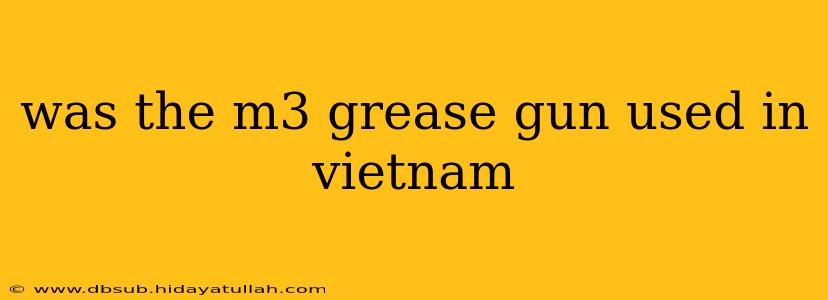The M3 "Grease Gun," a submachine gun synonymous with American military history, saw extensive use across various conflicts. But was the M3 Grease Gun used in Vietnam? The short answer is a resounding yes, though perhaps not to the extent of some other weapons. Understanding its role requires examining its strengths, weaknesses, and the overall context of the Vietnam War.
The M3 Grease Gun: A Brief Overview
Before delving into its use in Vietnam, let's quickly recap the M3's history. Developed during World War II, this submachine gun was renowned for its simplicity, affordability, and relatively high rate of fire. Its open-bolt design contributed to its reliability and ease of manufacture, making it a vital weapon for the Allied forces. However, its design also meant certain drawbacks, such as its lower accuracy compared to other submachine guns and a higher recoil.
The M3 Grease Gun in Vietnam: A Supporting Role
While the M16 rifle eventually became the iconic weapon of the Vietnam War, the M3 Grease Gun found its niche. It wasn't the primary weapon of choice for many units, but it filled a specific role:
Close-Quarters Combat and Urban Warfare
The M3's high rate of fire and compact size made it advantageous in close-quarters combat situations common in urban areas and during jungle skirmishes. Its simplicity meant it could be easily maintained and repaired, even in harsh conditions. This was a critical advantage in a conflict characterized by intense, unpredictable engagements.
Secondary Weapon and Support Role
Many soldiers carried the M3 as a secondary weapon, supplementing their primary rifle. This provided a powerful close-range backup in situations where the rifle might be less effective or impractical. Its simplicity and ease of use also made it suitable for support personnel who might not require the precision of a rifle.
Limited Availability and Replacement by Other Weapons
It's important to note that the M3's usage in Vietnam wasn't as prevalent as during WWII. The M16's introduction, with its superior accuracy and range, gradually reduced the demand for the Grease Gun. Furthermore, the availability of the M3 might have been limited due to logistical considerations and the preference for newer weapon systems.
Why the M3 Wasn't Ubiquitous in Vietnam
The M3's limitations compared to more modern weapons contributed to its less prominent role in Vietnam:
- Accuracy: The M3's inherent inaccuracy compared to the M16 made it less effective in longer-range engagements, a common occurrence in the Vietnam War's diverse terrains.
- Ammunition: The .45 ACP ammunition used by the M3, while powerful at close range, was heavier than the M16's 5.56mm ammunition, impacting a soldier's carrying capacity.
- Technological Advancements: The development of more advanced weaponry such as the M16 and the CAR-15 rendered the M3 somewhat obsolete, though its unique characteristics still made it valuable in specific contexts.
Conclusion: A Relic of a Bygone Era, Yet Still Relevant
While not the star weapon of the Vietnam War, the M3 Grease Gun certainly played a role. Its presence on the battlefields of Vietnam underscores its enduring legacy as a simple, reliable, and effective close-quarters combat weapon, albeit one gradually superseded by newer technologies. Its historical significance remains firmly etched in the annals of military history, even if its dominance had waned by the time of the Vietnam War. The M3’s story is one of adaptation and evolution, showcasing how even seemingly outdated weaponry can find a place in the complexities of armed conflict.
